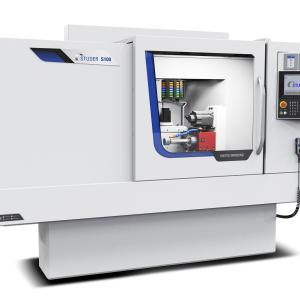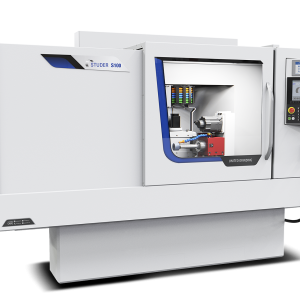Contact Details

With regular new developments every 6 months, Fritz Studer AG says it has surprised users of internal cylindrical grinding machines in the last 2 years. What still appeared as a separate machine with the S141 universal machine (component length up to 1,300 mm) in May 2014 has evolved into a complete machine platform with the universal machines in the S141 and S151 series in autumn 2014, the S131 universal machine and the S122 production machine in spring 2015 as well as the S121 universal machine in autumn 2015. STUDER is completing this platform with a final coup: The Thun grinding machine specialist is bringing three new radius internal cylindrical grinding machines to market to replace the successful CT700 and CT900 models.
The main fields of application of the new S121, S131 and S141 radius grinding machines are the manufacture of dies, especially in the packaging industry, where tungsten carbide and ceramic are primarily processed, and the production of hydraulic components, such as axial pump pistons, guide plates and housings made of hardened steel, cast iron and copper. Other fields are the production of complex workpieces with several tapers greater than 20° to 90° in a single clamping, where the main applications are in watch and medical technology with extra-hard materials such as industrial ceramic, sapphire and tungsten carbide, as well as the manufacture of human implants for shoulders, knees and hips from ceramic and titanium.
In the past, this range of parts was successfully covered by STUDER universal internal cylindrical grinding machines CT750 and CT960. With its market entry, the new S121 radius grinding machine will now take over the range of applications of the CT750, while the S131 has been designed for the previous component range of the CT960. New with the S141 radius grinding machine is, that the machining of larger workpieces is also now possible. For the user, this means in figures: The swing diameter above table is 250 mm for the S121, 300 mm for the S131 and 400 mm for the S141. External diameters up to 160 mm can now be machined with an external grinding wheel 250 mm in diameter. The maximum length of parts including clamping device is 300 mm for all three radius grinding machines, and the maximum workpiece weight including clamping device is 100 kg.
There are good reasons why STUDER is replacing the successful CT models, which translate into increased customer benefit. First and foremost, a higher level of technology has been achieved with the new radius grinding machines. This is evident in the machine bed, which now comprises of Granitan and thus offers higher dampening levels, thermal stability and guidance accuracy. It is also reflected in the StuderGuide guideway and drive system with linear motors, which features high wear resistance, a long working life and high dynamics (interpolation possibility). The main benefit which customers can derive from the new machines is the extended range of parts possible due to the larger size of the machine, and the new dressing concept which, thanks to the new arrangement on the B-axis (simultaneously swiveling workpiece table) is not only simpler, but also offers greater thermal stability and mechanical rigidity. The fact that the new S121, S131 and S141 are now also manufactured according to the Thun modular principle also means non-variable parts in maintenance and service and consequently a higher availability of service technicians. It also means harmonization of the components and, with the new design and improved ergonomics, an increase in the machine's value.
Special mention should be made of the StuderSIM software in regard to the new radius grinding machines. With this software, STUDER answers the question of what an operator needs in order to be able to machine complex parts – often in a single clamping. The answer: An assistant, with which workpieces – derived from a drawing – can be completely defined, all necessary geometric data for the grinding cycles can be generated and with which the grinding process can be checked and visualized by means of simulation on a PC or on the machine. StuderSIM is this powerful assistant. It is complemented by hardware which features the previously mentioned Granitan machine bed and the StuderGuide guideway and drive system with linear motors. It also includes X and Z-axes in a cross-slide arrangement as well as a cross slide, which in the case of the S121 can either take one spindle, two spindles in parallel or two spindles on a hydraulic turret, and in the case of the S131 and S141 comes with a 4-position turret with direct drive. The machines are also equipped with a workhead on a simultaneously swiveling B-axis, a dressing spindle or a fixed dresser on the B-axis and a measuring probe on the grinding head. Other new features are, finally, the enclosure and the control console in the STUDER design.
The S121, S131 and S141 radius grinding machines differ from the universal cylindrical grinding machines of the same name in a number of technical details. The B-axes of the radius grinding machines are set up simultaneously and offer interpolation (from -60° to +90°), while the universal cylindrical grinding machines have a swiveling table, which can be positioned from -10° to +20°. In addition, the spindles on the radius grinding machines are arranged at the rear of the turret, while this is the other way round on the cylindrical grinding machines: they are at the front. There are also differences in the dressing concept. The radius grinding machines have the dresser on the B-axis, while the cylindrical grinding machines are equipped with two swiveling dressers. Last but not least, the S121 to S151 cylindrical grinding machines use the STUDER operating system StuderWIN, while the new radius grinding machines use the StuderSIM operating system.
With the market entry of the S121, S131 and S141 radius grinding machines, the platform of STUDER internal cylindrical grinding machines is now complete and rounded. In addition to the new radius grinding machines, the platform includes the simple S110 and S120 machines, the S121 to S151 universal internal grinding machines and the S122 production internal grinding machine. Five machines have been replaced (S120, S145, S151, CT700, CT900), enabling four new market segments to be opened up. The S121 universal internal grinding machines are small machines for a large application range, the S122 production internal grinding machine is a machine for large component output and high availability, and the S141 and S151 universal internal grinding machines (700 and 1300 mm) are machines for long workpieces. Finally, a fourth market segment is opened up with the new S141 radius grinding machine for parts up to 400 mm in diameter.
Related Glossary Terms
- cylindrical grinding
cylindrical grinding
Grinding operation in which the workpiece is rotated around a fixed axis while the grinding wheel is fed into the outside surface in controlled relation to the axis of rotation. The workpiece is usually cylindrical, but it may be tapered or curvilinear in profile. See centerless grinding; grinding.
- dressing
dressing
Removal of undesirable materials from “loaded” grinding wheels using a single- or multi-point diamond or other tool. The process also exposes unused, sharp abrasive points. See loading; truing.
- grinding
grinding
Machining operation in which material is removed from the workpiece by a powered abrasive wheel, stone, belt, paste, sheet, compound, slurry, etc. Takes various forms: surface grinding (creates flat and/or squared surfaces); cylindrical grinding (for external cylindrical and tapered shapes, fillets, undercuts, etc.); centerless grinding; chamfering; thread and form grinding; tool and cutter grinding; offhand grinding; lapping and polishing (grinding with extremely fine grits to create ultrasmooth surfaces); honing; and disc grinding.
- grinding machine
grinding machine
Powers a grinding wheel or other abrasive tool for the purpose of removing metal and finishing workpieces to close tolerances. Provides smooth, square, parallel and accurate workpiece surfaces. When ultrasmooth surfaces and finishes on the order of microns are required, lapping and honing machines (precision grinders that run abrasives with extremely fine, uniform grits) are used. In its “finishing” role, the grinder is perhaps the most widely used machine tool. Various styles are available: bench and pedestal grinders for sharpening lathe bits and drills; surface grinders for producing square, parallel, smooth and accurate parts; cylindrical and centerless grinders; center-hole grinders; form grinders; facemill and endmill grinders; gear-cutting grinders; jig grinders; abrasive belt (backstand, swing-frame, belt-roll) grinders; tool and cutter grinders for sharpening and resharpening cutting tools; carbide grinders; hand-held die grinders; and abrasive cutoff saws.
- grinding wheel
grinding wheel
Wheel formed from abrasive material mixed in a suitable matrix. Takes a variety of shapes but falls into two basic categories: one that cuts on its periphery, as in reciprocating grinding, and one that cuts on its side or face, as in tool and cutter grinding.
- interpolation
interpolation
Process of generating a sufficient number of positioning commands for the servomotors driving the machine tool so the path of the tool closely approximates the ideal path. See CNC, computer numerical control; NC, numerical control.
- parallel
parallel
Strip or block of precision-ground stock used to elevate a workpiece, while keeping it parallel to the worktable, to prevent cutter/table contact.
- tungsten carbide ( WC)
tungsten carbide ( WC)
Intermetallic compound consisting of equal parts, by atomic weight, of tungsten and carbon. Sometimes tungsten carbide is used in reference to the cemented tungsten carbide material with cobalt added and/or with titanium carbide or tantalum carbide added. Thus, the tungsten carbide may be used to refer to pure tungsten carbide as well as co-bonded tungsten carbide, which may or may not contain added titanium carbide and/or tantalum carbide.
- wear resistance
wear resistance
Ability of the tool to withstand stresses that cause it to wear during cutting; an attribute linked to alloy composition, base material, thermal conditions, type of tooling and operation and other variables.











 PRODUCTS
PRODUCTS

